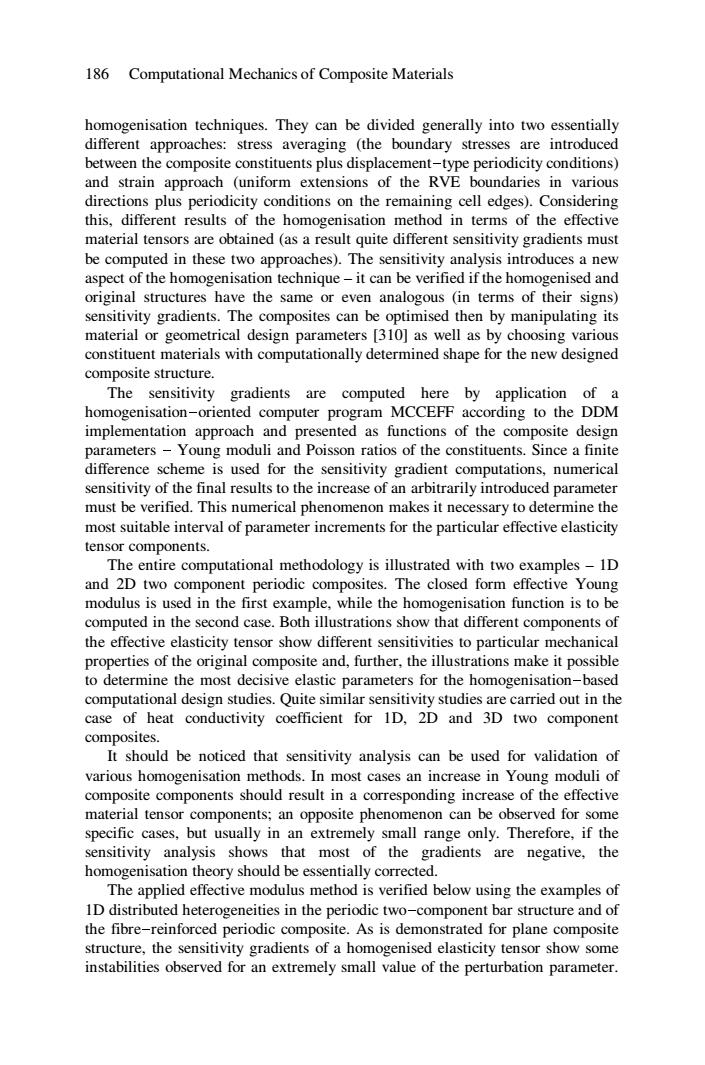正在加载图片...

186 Computational Mechanics of Composite Materials homogenisation techniques.They can be divided generally into two essentially different approaches:stress averaging (the boundary stresses are introduced between the composite constituents plus displacement-type periodicity conditions) and strain approach (uniform extensions of the RVE boundaries in various directions plus periodicity conditions on the remaining cell edges).Considering this,different results of the homogenisation method in terms of the effective material tensors are obtained(as a result quite different sensitivity gradients must be computed in these two approaches).The sensitivity analysis introduces a new aspect of the homogenisation technique-it can be verified if the homogenised and original structures have the same or even analogous (in terms of their signs) sensitivity gradients.The composites can be optimised then by manipulating its material or geometrical design parameters [310]as well as by choosing various constituent materials with computationally determined shape for the new designed composite structure. The sensitivity gradients are computed here by application of a homogenisation-oriented computer program MCCEFF according to the DDM implementation approach and presented as functions of the composite design parameters -Young moduli and Poisson ratios of the constituents.Since a finite difference scheme is used for the sensitivity gradient computations,numerical sensitivity of the final results to the increase of an arbitrarily introduced parameter must be verified.This numerical phenomenon makes it necessary to determine the most suitable interval of parameter increments for the particular effective elasticity tensor components. The entire computational methodology is illustrated with two examples-1D and 2D two component periodic composites.The closed form effective Young modulus is used in the first example,while the homogenisation function is to be computed in the second case.Both illustrations show that different components of the effective elasticity tensor show different sensitivities to particular mechanical properties of the original composite and,further,the illustrations make it possible to determine the most decisive elastic parameters for the homogenisation-based computational design studies.Quite similar sensitivity studies are carried out in the case of heat conductivity coefficient for 1D,2D and 3D two component composites. It should be noticed that sensitivity analysis can be used for validation of various homogenisation methods.In most cases an increase in Young moduli of composite components should result in a corresponding increase of the effective material tensor components;an opposite phenomenon can be observed for some specific cases,but usually in an extremely small range only.Therefore,if the sensitivity analysis shows that most of the gradients are negative,the homogenisation theory should be essentially corrected. The applied effective modulus method is verified below using the examples of 1D distributed heterogeneities in the periodic two-component bar structure and of the fibre-reinforced periodic composite.As is demonstrated for plane composite structure,the sensitivity gradients of a homogenised elasticity tensor show some instabilities observed for an extremely small value of the perturbation parameter.186 Computational Mechanics of Composite Materials homogenisation techniques. They can be divided generally into two essentially different approaches: stress averaging (the boundary stresses are introduced between the composite constituents plus displacement-type periodicity conditions) and strain approach (uniform extensions of the RVE boundaries in various directions plus periodicity conditions on the remaining cell edges). Considering this, different results of the homogenisation method in terms of the effective material tensors are obtained (as a result quite different sensitivity gradients must be computed in these two approaches). The sensitivity analysis introduces a new aspect of the homogenisation technique – it can be verified if the homogenised and original structures have the same or even analogous (in terms of their signs) sensitivity gradients. The composites can be optimised then by manipulating its material or geometrical design parameters [310] as well as by choosing various constituent materials with computationally determined shape for the new designed composite structure. The sensitivity gradients are computed here by application of a homogenisation-oriented computer program MCCEFF according to the DDM implementation approach and presented as functions of the composite design parameters - Young moduli and Poisson ratios of the constituents. Since a finite difference scheme is used for the sensitivity gradient computations, numerical sensitivity of the final results to the increase of an arbitrarily introduced parameter must be verified. This numerical phenomenon makes it necessary to determine the most suitable interval of parameter increments for the particular effective elasticity tensor components. The entire computational methodology is illustrated with two examples – 1D and 2D two component periodic composites. The closed form effective Young modulus is used in the first example, while the homogenisation function is to be computed in the second case. Both illustrations show that different components of the effective elasticity tensor show different sensitivities to particular mechanical properties of the original composite and, further, the illustrations make it possible to determine the most decisive elastic parameters for the homogenisation-based computational design studies. Quite similar sensitivity studies are carried out in the case of heat conductivity coefficient for 1D, 2D and 3D two component composites. It should be noticed that sensitivity analysis can be used for validation of various homogenisation methods. In most cases an increase in Young moduli of composite components should result in a corresponding increase of the effective material tensor components; an opposite phenomenon can be observed for some specific cases, but usually in an extremely small range only. Therefore, if the sensitivity analysis shows that most of the gradients are negative, the homogenisation theory should be essentially corrected. The applied effective modulus method is verified below using the examples of 1D distributed heterogeneities in the periodic two-component bar structure and of the fibre-reinforced periodic composite. As is demonstrated for plane composite structure, the sensitivity gradients of a homogenised elasticity tensor show some instabilities observed for an extremely small value of the perturbation parameter